Evolution of Metabolic Phenotypes of Obesity in Coronary Patients after 5 Years of Dietary Intervention: From the CORDIOPREV Study
Autor
Martín-Piedra, Laura
Alcalá Díaz, Juan Francisco
Gutiérrez Mariscal, Francisco Miguel
Arenas de Larriva, Antonio P.
Romero-Cabrera, Juan Luis
Torres‑Peña, J.D.
Caballero-Villarraso, Javier
Luque, Raúl M.
Pérez-Martínez, Pablo
López-Miranda, José
Delgado-Lista, Javier
Editor
MDPIFecha
2021Materia
Obesity metabolic phenotypesMetabolically healthy obese
Metabolically unhealthy obese
Fatty liver index
Diet intervention
Mediterranean diet
Low-fat diet
Coronary patients
METS:
Mostrar el registro METSPREMIS:
Mostrar el registro PREMISMetadatos
Mostrar el registro completo del ítemResumen
Background: Obesity phenotypes with different metabolic status have been described previously. We analyzed metabolic phenotypes in obese coronary patients during a 5-year follow-up, and examined the factors influencing this evolution. Methods: The CORDIOPREV study is a randomized, long-term secondary prevention study with two healthy diets: Mediterranean and low-fat. All obese patients were classified as either metabolically healthy obese (MHO) or metabolically unhealthy obese (MUO). We evaluated the changes in the metabolic phenotypes and related variables after 5 years of dietary intervention. Results: Initially, 562 out of the 1002 CORDIOPREV patients were obese. After 5 years, 476 obese patients maintained their clinical and dietary visits; 71.8% of MHO patients changed to unhealthy phenotypes (MHO-Progressors), whereas the MHO patients who maintained healthy phenotypes (MHO-Non-Progressors) lost more in terms of their body mass index (BMI) and had a lower fatty liver index (FLI-score) (p < 0.05). Most of the MUO (92%) patients maintained unhealthy phenotypes (MUO-Non-Responders), but 8% became metabolically healthy (MUO-Responders) after a significant decrease in their BMI and FLI-score, with improvement in all metabolic criteria. No differences were found among dietary groups. Conclusions: A greater loss of weight and liver fat is associated with a lower progression of the MHO phenotype to unhealthy phenotypes. Likewise, a marked improvement in these parameters is associated with regression from MUO to healthy phenotypes.

